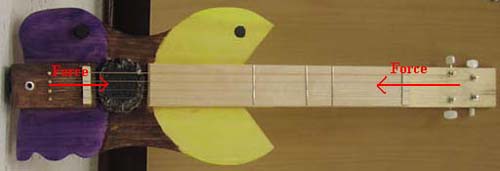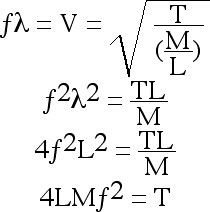On a guitar, the strings are the source of a significant amount of force.

Guitar body with forces shown.
This force is an inward force, and it is anchored slightly above the surface of the guitar. Because the strings are exerting a force across the joint between the neck and the body, parallel to the joint, there is a shearing effect along the joint as well.

Diagram of the shear effect.
Well, these force diagrams are interesting, but what are the specific forces? The next step is a description of how to calculate the total forces.
To start off, we have the following equations that relate the tension forces on the string to other relevant variables:
![]()

In these two equations, ƒ represents the fundamental frequency of the string, T represents the tension of the string, M represents the mass of the string, L represents the length of the string, V represents the velocity of the wave that travels along the string, and l represents the wavelength of the fundamental wave on the string. By definition, the fundamental wavelength is twice the length of the string, so l = 2L. Given that, the following derivation can be made:

Equations relating velocity to tension, mass, and length.
The final step of this derivation is an equation of T in terms of a number of variables that we can measure fairly easily. Here is a chart of the values of those variables for the four strings, and for the corresponding value of T when the given values are plugged into the derived equation:
| STRING # |
|
M(g) | L(m) | T(N) |
|---|---|---|---|---|
| String 1 | 98 | 0.00292 | 0.785 | 88.06 |
| String 2 | 147 | 0.00157 | 0.77 | 104.4 |
| String 3 | 196 | 0.00079 | 0.765 | 92.87 |
| String 4 | 247 | 0.00041 | 0.75 | 75.04 |
The strings are numbered in order from thickest to thinnest. The strings are the only things exerting forces on the guitar body; therefore, the sum of their tensions will be equal to the net force on the joint between the neck and the body of the guitar. The sum of the tensions listed above is 360.5 N.
Shearing is defined as force per unit area. The area over which the neck connects to the body of the guitar is 12.5 inches2; this is approximately 8.065E-3 m2. Divide the net force by this area, and the net shearing is 44,700 N/m2.
As you can see from the formula derived above, string tension, string frequency, and string length are all closely interrelated. Placing a piece of birch plywood along the length of the neck decreases the distance that you need to push down the string in order to hold it against the wood, thus changing its length. By making string tension more constant, this allows the strings to act more predictably, and thus to be in tune when you hold them down at the distance from the nut blanks that you would normally expect to be correct.
